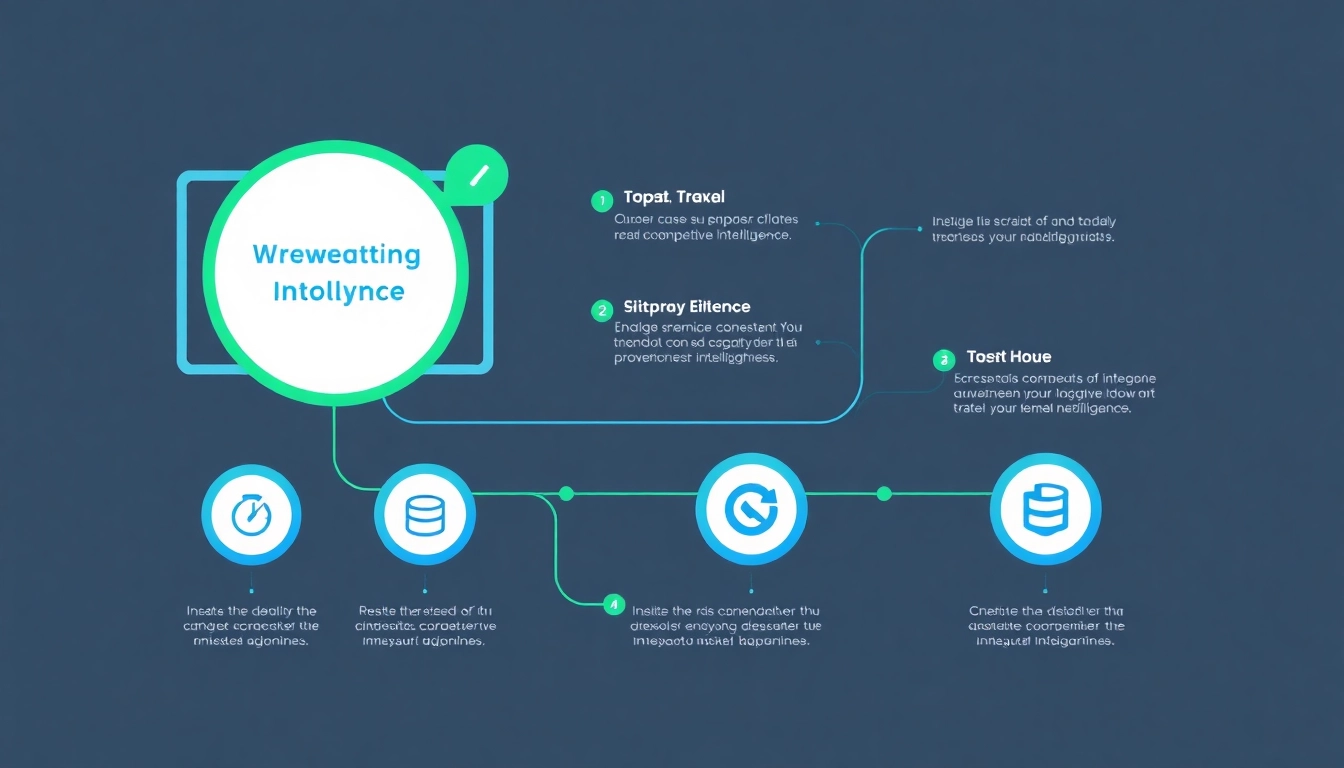Understanding Competitive Intelligence
In today’s fast-paced business environment, the ability to gather and analyze competitive intelligence (CI) is crucial for success. Competitive intelligence encompasses a range of practices aimed at understanding the competitive landscape, including gathering information on competitors, market conditions, and consumer behavior. This article will explore the multifaceted nature of competitive intelligence, why it is essential for businesses, and how to effectively implement it to gain a strategic advantage.
What is Competitive Intelligence?
Competitive Intelligence refers to the systematic process of gathering, analyzing, and disseminating information that is of strategic importance to an organization. It involves understanding the external environment, including competitors, market trends, and consumer preferences. According to sources such as Competitive intelligence, this practice allows organizations to make informed decisions and craft effective strategies that anticipate market shifts.
The Importance of Competitive Intelligence for Businesses
The importance of competitive intelligence cannot be underestimated. In an era where information is abundant, the ability to filter and interpret this data is what sets thriving companies apart from their competitors. Businesses that leverage CI can enhance their market positioning, optimize their operational efficiency, and anticipate customer needs. Ultimately, effective competitive intelligence aids in reducing risks, identifying opportunities for innovation, and fostering proactive decision-making.
Key Concepts in Competitive Intelligence
Several key concepts underpin the field of competitive intelligence:
- Data Collection: This involves systematically collecting data from various sources, including competitor websites, industry reports, customer feedback, and social media. Effective CI requires a diverse array of data sources to provide a comprehensive picture of the competitive landscape.
- Analysis: Gathering data is only the first step; it must then be analyzed to extract meaningful insights. Techniques such as SWOT analysis (Strengths, Weaknesses, Opportunities, Threats) and Porter’s Five Forces can be employed to evaluate competitive conditions.
- Dissemination: The final stage of the competitive intelligence process involves sharing insights with relevant stakeholders. This can be through reports, presentations, or meetings to ensure that the information is actionable and leads to informed decision-making.
Types of Competitive Intelligence
Market Intelligence vs. Competitor Intelligence
Two fundamental categories of competitive intelligence are market intelligence and competitor intelligence.
Market Intelligence refers to the broader analysis of market dynamics, including trends, customer behavior, and overall industry performance. This type of intelligence helps organizations understand where the market is heading and spot emerging opportunities or threats.
Competitor Intelligence, on the other hand, focuses specifically on gathering insights about competitors’ strategies, strengths, and weaknesses. This includes monitoring competitors’ marketing efforts, product launches, and pricing strategies. By understanding competitors, businesses can identify areas where they can differentiate themselves effectively.
Operational Intelligence: Enhancing Business Performance
Operational intelligence is a type of competitive intelligence that focuses on improving the internal processes of an organization. It involves analyzing operational data to enhance efficiency, reduce costs, and improve service delivery. By leveraging operational intelligence, companies can streamline their supply chain logistics, optimize labor resources, and refine project management practices. This not only leads to improved productivity but also positions a business competitively within its market.
Customer Intelligence: Mapping Consumer Behavior
Understanding customer behavior is paramount for any organization seeking to succeed. Customer intelligence involves gathering data about customer preferences, purchasing habits, and feedback mechanisms. This intelligence can be utilized to develop tailored marketing strategies and improve product offerings. Through methods such as surveys, focus groups, and data analytics, businesses can gain valuable insights that inform their customer engagement strategies and enhance customer satisfaction.
Tools and Techniques for Competitive Intelligence
Essential Tools for Gathering Competitive Insights
There are numerous tools available for gathering competitive intelligence that cater to various organizational needs. Popular tools include:
- SEMrush: Widely used for SEO and competitor analysis, SEMrush provides insights into keyword performance and digital marketing strategies utilized by competitors.
- Ahrefs: Similar to SEMrush, Ahrefs offers detailed backlink analysis, enabling businesses to understand their competitors’ link-building strategies.
- Owler: This platform allows users to track competitor updates, funding rounds, and company news, facilitating the monitoring of industry dynamics.
- SpyFu: An excellent tool for tracking paid ad campaigns, SpyFu helps organizations understand which keywords their competitors are targeting and how effectively they are doing so.
Data Analysis Techniques: Making Sense of Information
Once data has been collected, the next step is to analyze it effectively. Here are some key analysis techniques:
- Trend Analysis: By identifying patterns over time, organizations can forecast future shifts in the market and adjust their strategies accordingly.
- Competitive Benchmarking: This involves comparing organizational performance against competitors to identify gaps and areas for improvement.
- Data Visualization: Utilizing charts, graphs, and dashboards can help stakeholders quickly grasp complex data, enabling more informed decision-making.
Best Practices in Implementing Competitive Intelligence Tools
Implementing competitive intelligence tools is not merely about choosing the right software; it requires a strategic approach:
- Define Objectives: Clearly outline what you aim to achieve with competitive intelligence efforts. This could range from increasing market share to enhancing customer satisfaction.
- Train Employees: Ensure that team members are trained on how to use competitive intelligence tools effectively and understand the insights that can be derived from the data. This promotes a culture of data-driven decision-making.
- Regularly Update Intelligence: The business environment is dynamic, so CI must be an ongoing process. Regularly updating your data sources and analysis techniques will ensure that you remain competitive.
Challenges in Implementing Competitive Intelligence
Common Obstacles in CI Strategies
While the benefits of competitive intelligence are overwhelming, organizations often face challenges in its implementation:
- Data Overload: The sheer volume of data available can be overwhelming. Organizations must develop strategies to sift through information and focus on what is truly relevant.
- Resource Constraints: Limited resources can hinder the effectiveness of CI efforts. Many organizations may not have dedicated personnel or sufficient budgets allocated for intelligence gathering and analysis.
- Resistance to Change: Cultural resistance within an organization can impede the adoption of CI initiatives. Encouraging a mindset receptive to data-driven insights is crucial.
Mitigating Risks Associated with Competitive Intelligence
To address the challenges in implementing competitive intelligence, organizations can take several measures:
- Establish Clear Protocols: Create a structured framework for data collection, analysis, and dissemination. This promotes consistency and ensures that all team members are aligned.
- Utilize Automation: Leveraging automation tools can help reduce the manual effort involved in data collection and analysis, allowing teams to focus on interpretation.
- Develop an Agile CI Strategy: Implementing a flexible competitive intelligence strategy allows businesses to adapt swiftly to market changes and emerging trends.
Legal and Ethical Considerations in Competitive Analysis
Ethics must underpin all competitive intelligence activities. Organizations should ensure that their data collection methods comply with legal standards and respect competitor privacy. Engagement in unethical practices, such as corporate espionage, can damage reputations and lead to significant legal repercussions. Promoting an ethical approach not only minimizes risks but also fosters trust within the industry.
Case Studies of Effective Competitive Intelligence
Success Stories: Companies Thriving with Competitive Intelligence
Examining organizations that have successfully implemented competitive intelligence offers valuable insights:
- Coca-Cola: The beverage giant employs extensive market and consumer intelligence to remain at the forefront of consumer preferences, customizing product offerings accordingly.
- Amazon: Utilizing advanced data analytics, Amazon tracks competitor pricing and adjusts its own to maintain a competitive edge, exemplifying operational intelligence.
- Netflix: Netflix’s use of customer intelligence enables it to analyze viewer behavior, leading to the production of original content that caters directly to audience preferences.
Lessons Learned from Real-World Implementations
From the successes of these companies, several lessons can be gleaned:
- Invest in data analytics capabilities to derive actionable insights.
- Continuously monitor market dynamics and competitor actions to stay relevant.
- Embrace a consumer-focused strategy that prioritizes customer satisfaction and engagement.
Future Trends in Competitive Intelligence
The landscape of competitive intelligence is continuously evolving. Future trends are likely to include:
- Artificial Intelligence: AI technologies will enhance data processing and analysis capabilities, allowing for deeper insights and predictions.
- Real-Time Analytics: The demand for instant insights is growing. Businesses will increasingly rely on tools that provide real-time intelligence to stay competitive.
- Increased Focus on Consumer Sentiments: As consumer preferences shift rapidly, companies will emphasize understanding emotional and behavioral metrics to drive decision-making and strategy.



